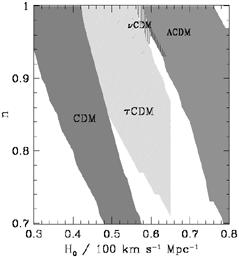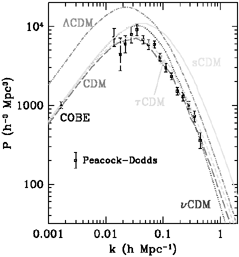


8.2 Present Status of Inflation + CDM
A useful way to organize the different CDM models is by their
dark matter content; within each CDM family, the cosmological
parameters can still vary: sCDM (for simple), only CDM and baryons;
 CDM: in addition to CDM and baryons
additional radiation (e.g., produced by the decay of an unstable
massive tau neutrino);
CDM: in addition to CDM and baryons
additional radiation (e.g., produced by the decay of an unstable
massive tau neutrino);  CDM: CDM,
baryons, and a dash of hot
dark matter (e.g.,
CDM: CDM,
baryons, and a dash of hot
dark matter (e.g., 
 = 0.2);
and
= 0.2);
and  CDM:
CDM, baryons, and a cosmological constant (e.g.,
CDM:
CDM, baryons, and a cosmological constant (e.g., 
 = 0.6).
In all these models, the total energy density sums to the critical
energy density; in all but
= 0.6).
In all these models, the total energy density sums to the critical
energy density; in all but  CDM,
CDM,  M = 1.
M = 1.

|
Figure 13. Acceptable cosmological
parameters for different
CDM models, as are characterized by their invisible
matter content: simple CDM (CDM), CDM plus cosmological constant
( |
Figure 13 summarizes the viability of these different
CDM models, based upon CMB measurements and current determinations of
the present power spectrum of fluctuations (derived from
redshift surveys; see Fig. 14).
sCDM is only viable for low values of the
Hubble constant (less than 55 km s-1 Mpc-1) and/or
significant tilt (deviation from scale invariance); the region
of viability for  CDM is similar to
sCDM, but shifted
to larger values of the Hubble constant (as large as
65 km s-1 Mpc-1).
CDM is similar to
sCDM, but shifted
to larger values of the Hubble constant (as large as
65 km s-1 Mpc-1).  CDM has an island of viability
around H0
CDM has an island of viability
around H0  60
km s-1 Mpc-1and n
60
km s-1 Mpc-1and n  0.95.
0.95.  CDM
can tolerate the largest values of the Hubble constant.
CDM
can tolerate the largest values of the Hubble constant.

|
Figure 14. The power spectrum of
fluctuations today, as traced by
bright galaxies (light), as derived from redshift surveys assuming
light traces mass
(Peacock and Dodds
1994).
The curves correspond to the
predictions of various cold dark matter models. The relationship
between the power spectrum and CMB anisotropy
in a |
Considering other relevant data too - e.g.,
age of the Universe, determinations of  M,
measurements of the Hubble constant, and limits to
M,
measurements of the Hubble constant, and limits to

 -
-  CDM emerges as the ``best-fit CDM
model'' (see e.g.,
Krauss & Turner 1995;
Ostriker & Steinhardt
1995).
Moreover, its ``key signature,'' q0 ~ -0.5, may have
been confirmed.
Given the possible systematic uncertainties
in the SNe1a data and other measurements, it is premature to conclude that
CDM emerges as the ``best-fit CDM
model'' (see e.g.,
Krauss & Turner 1995;
Ostriker & Steinhardt
1995).
Moreover, its ``key signature,'' q0 ~ -0.5, may have
been confirmed.
Given the possible systematic uncertainties
in the SNe1a data and other measurements, it is premature to conclude that
 CDM is anything but the model
to take aim at!
CDM is anything but the model
to take aim at!